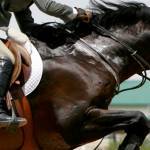Stallions: Are Breeding and Showing Mutually Exclusive?

Anecdotal reports indicate that stallions used for breeding while still competing in certain sports may not perform to expectations due to abnormal function of the back and hindquarters. Scientists recently revealed there might be some truth to these reports.
A group of veterinary researchers* suggested that the presumptive decrease in performance during show-jumping competition could be due to stress placed on the pelvis and hindquarters. According to that group, hind-limb retroflexion—or backward bending—during the suspension phase over an obstacle plays a critically important role during jumping. Limited or decreased ability to retroflex can affect performance.
The researchers wrote, “Hind-limb retroflexion over a jump requires extreme extension of the pelvis. When the hindquarters of the horse are above the fence, the lumbosacral joint extends, thereby elevating the hindquarters, and subsequently the hip joints will also extend to elevate the lower limbs.”
For anyone that’s witnessed semen collection using a phantom mare, extension of the hindquarters also occurs during this procedure. As such, overuse of the lumbosacral region could explain the long-held theory that breeding stallions have decreased athletic performance or vice versa.
To determine the validity of this theory, van Beuzekom and colleagues recruited six Warmblood stallions used for both semen collection and either show jumping or dressage. Using spherical skin markers, the horses were videotaped during semen collection to analyze the range of motion of various joints, focusing on the pelvis and hindquarters.
“The key finding of the study was that the pelvis undergoes both hyperflexion and hyperextension, seemingly similar to excursions during show jumping. That said, very different loading on musculoskeletal structures may occur during semen collection because the horse is standing in a relatively fixed position,” summarized Kathleen Crandell, Ph.D., a Kentucky Equine Research (KER) nutritionist.
She added, “Consider also that there may be abnormal stresses placed on the musculoskeletal tissues of the hind end caused by asymmetric forces on those tissues as a result of the angle of approach to the phantom mare. As the researchers pointed out, those movements could exacerbate subclinical locomotor pain in the hindquarters initially induced by the demands of high-level athletic performance.”
Nutritional support of stallions is vital. “KER offers several nutritional supplements that foster musculoskeletal health prior to any injury or trauma. Synovate HA, KER-Flex, and EO-3 all have scientific studies supporting their use for optimizing joint health,” noted Crandell.
Australian horse owners should look for these products.
*van Beuzekom, E.L., A.C. Hoogendoorn, B. Colenbrander, et al. Hindquarter movement of sporthorse stallions during semen collection. Journal of Equine Veterinary Science 50:100-104.








